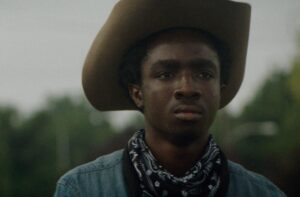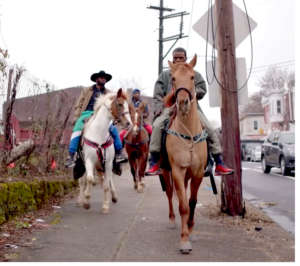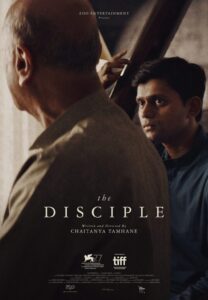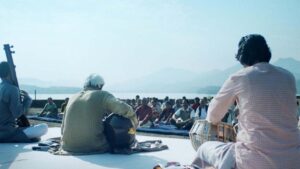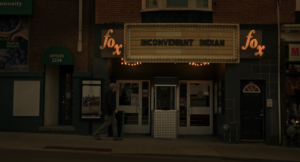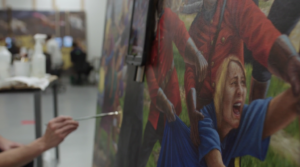Concrete Cowboy | Directed by Ricky Staub | Written by Staub and Dan Walser, based on the book by Greg Neri | 111 min
Knowing this film is based on a Young Adult novel explains a lot about a narrative that seems a lot less complex than it promises to be early on. Fourteen-year-old Cole (Caleb McLaughlin, one of the kids on Stranger Things) is getting into fights at his high school in Detroit, so his mother sends him to spend the summer with his estranged father, Harp (Idris Elba), who considers himself something of an urban cowboy — though not related to the John Travolta ’80s movie. This is based on an actual Philadelphia subculture, the Fletcher Street Urban Riding Club and The Black Cowboys, helping to teach young people about horses.
It’s the backdrop of horse culture and the location details that help distinguish this otherwise entirely conventional story. We get a series of scenes that would be more common in a western, including the campfire drinks, singalong, and bullshit sesh, the horse racing, and even the horse thieving. That’s fresh for a coming-of-age story set in the city, but then there’s the almost instant teen panacea of hard work and horse care for Cole, who never really gets a chance to explain why he was troubled in the first place — he just missed his father? We get the bad-influence bestie (Jharrel Jerome) who dreams of, wait what? Flipping ranch houses in the west? The script occasionally strays into the ridiculous, which is a major drawback in what’s otherwise a promising scenario.
If you’ve been paying attention you’ll be able to predict every second plot development as the film gradually, literally and figuratively, leads the horses out of the stable, but the heart in the characters and the opportunity to see something authentic in American life that’s never been given much of a chance on the big screen, those things makes Concrete Cowboy worth a taking for a ride.
The Disciple | Written and Directed by Chaitanya Tamhane | 130 min
Back in 2015, Carbon Arc Cinema screened Tamhane’s first feature, Court, the delightfully droll satire of the Indian criminal justice system. It explored a case of a folk singer who may have inspired a sewer worker to commit suicide. Tamhane’s second feature is another examination of Indian culture, a remarkably thoughtful, nuanced look at the pursuit of excellence and the acceptance of failure — once again with music at its core. Imagine an Indian Whiplash as your jumping-off point, before expanding outward.
Aditya Modak plays a 20-something Indian classical music student, Sharad Nerulkar, living in Mumbai who’s desperate to live up to the high standards of his art — we flash back to his childhood where his father instilled in him the rigid standards of greatness, inspired by a performer who never was recorded beyond secret tapes of her spoken voice espousing the impossible philosophy of this music — you can only be great with 10 lifetimes of devotion. Sharad learns from a guru (Dr. Arun Dravid) passing on the same lessons, but Sharad may not have the talent required, even while he has the discipline.
Tamhane shoots most of his film with characters in a comfortable mid-ground. It’s democratizing, and frames Sharad as one of many, caring deeply for his dreams to the exception of a lot of what’s around him. But when we flash forward a decade, we see through the framing of an Idol style show the tension between what a new generation wants versus the old, and how Sharad’s entire belief system may have been constructed on lies. There’s a scene where, in the midst of a performance, his remaining hope in himself shatters just as he’s achieving something emotionally transcendent — he’s become so self-critical, he can’t appreciate the moment.
I’m sure there’s a lot that’s particular to the role of Indian classical music within the Indian society that gets lost in translation, but what’s entirely universal is the exploration of the value of art, the negotiations with mediocrity, and finding a way to live with yourself through the many humiliations of putting your creativity into the world. The Disciple is seriously impressive.
Inconvenient Indian | Directed by Michelle Latimer, inspired by the book by Thomas King | 90 min
A Canadian documentary that lays out the misleading and damaging image of indigenous peoples in the white majority culture — thanks, Hollywood — and the fight for equality, for the preservation of their own culture, and what’s being done for First Nations and the Inuit to feel connected to their ancestors and to the land. There’s so much valuable, fascinating content here — much of it gleaned, I expect, from King’s book — but the film is casual with how it offers some of its information. It’s not a fatal flaw, but a disappointing one.
Latimer introduces King front and centre as he talks about the image of the “Indian,” tied to objects at the Royal Ontario Museum that are “unthreatening and without agency.” It makes clear this history is “the story we tell about the past — agreed upon interpretations,” and that “Indians” are “a series of entertainments … [a story about] the inevitable native acquiescence to commerce and Christianity.”
The most potent moment is the section on the genocidal practice of forced reeducation — starting with a tour of the famed Kent Monkman exhibit on that subject, and getting to the core of colonizers’ feelings of blamelessness. We see footage from residential schools, and hear discussions of language and culture shaming.
After that, Latimer spends the last half of the film showing where indigenous culture is thriving, challenging the media and settler imposition of identity — in education, arts, the digital realm, and where traditional practices are being preserved, highlighting talent such as Christi Belcourt, A Tribe Called Red, and Nyla Innuksuk.
But, I kept wondering who many of these people are and the particulars of their situations. Latimer doesn’t offer any names until the final credits, and even then we don’t get a lot of other detail. I recognized A Tribe Called Red from their sound, but more identifiers would’ve been welcome.
More frustrating is footage of indigenous protesters and protectors clashing with white cops and security personnel. While the material is vivid, intense, and emotional, I wanted to know where and when this was happening. Was this shot at Wet’suwet’en, or Dakota? This lack of journalistic rigour is exactly the ammunition those who support a racist status quo could use against a film like this. While I appreciate the narrative here is unorthodox and this is a filmmaker reclaiming her own story, facts and context are important — they deny propaganda.







